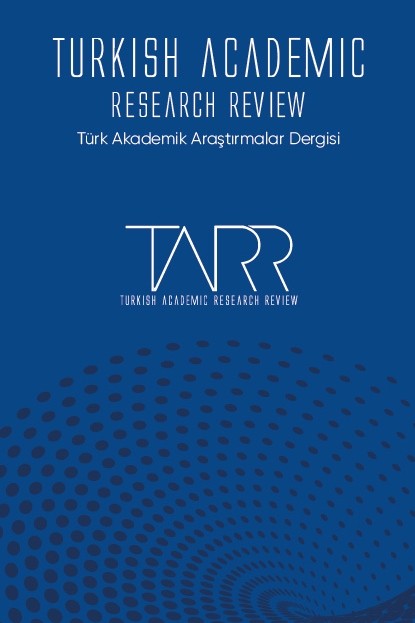Şeytanın Avukatı ve Goethe’nın Faustus Adlı Yapıtlarında Geçen Şeytan Temasının Anametinsellik Açısından Karşılaştırmalı İncelenmesi
Şeytanın tarihine bakıldığında, şeytanla içiçe geçen kötülüğün Şeytan’dan ayrıştığını, daha iyisinin yerini kötülüğe bıraktığını görülmektedir. Şeytan, uzun süren dinsel bir geçmişe sahip iken, kötülük modern ya da bugünü de kapsayan yakın geçmişin bir sorunu olarak kabul edilmekte, sanatın bütün formlarında karşılık bulmaktadır. Günümüzde, Batı Edebiyat ve kültür dünyasında sıklıkla kullanılan “devilistik image”, “faustik, faustvari, faustça yaklaşım” temaları somut bir düşüncenin varlığına dair bilgiler sunmaktadır. Her ne kadar bunlar halk efsanesi olarak görülse de sanatın farklı türlerinde imge olarak yerini almışlardır. Özellikle Alman Edebiyatından Johann Wolfgang Goethe’nin ünlü eseri Faust’ta insanın şeytan tarafından yoldan çıkarılması hikâyesi batı insanının kültürel kodlarına etki eden en çarpıcı örneklerdendir. Şeytanın her daim insanın peşinde olduğu düşüncesi köklü bir korku malzemesi oluşturmuştur. Aynı anlayış günümüz sinemasında da “Şeytanın Avukatı” adlı filmde görsel uyarlamalarla yerini almış, etkin örnekleme ve göndermeleriyle iyi bir örnek sergilemiştir. Tarihte ve günümüzde çekinilerek yaklaşılan bu konuya gerek batıda gerekse doğuda çok yer verilmediği incelemeler esnasında gözlenmiştir. Hatta edebiyatımızda konuyla ilgili olarak batıya kıyasla yok denecek kadar az eser verildiği görülmektedir. Düşünsel açıdan ise yapılan incelemeyle gerçekleştirilmek istenen, tasavvufta her şeyin zıddıyla gerçekleştiği düşüncesinden hareketle karşıt anlayış uygulamalarına da yer vermektir. Bu çalışmanın amacı, sanatın değişik yönlerini temsil eden bu iki yapıtta uyarlanan “Şeytan Teması”nın ana metinsellik açısından incelenmesini içermektedir. Çalışmada öncelikle giriş bölümünde tarihsel anlamda kötülük ve şeytan temalarına, incelemede yöntem olarak kullanılacak olan ana metinsellikle ilgili açıklamalara, her bir yapıtta geçen Şeytan temalarına ve karşılaştırmalarına, yapıtların ana metinsellik açısından değerlendirilmelerine, konuyla ilgili tespit ve bulgulara sonuç bölümünde yer verilecektir.
Anahtar Kelimeler:
Şeytan, Şeytan Teması, Şeytanın Avukatı, Faustus, Anametinsellik
A Comparative Study on the Devil Theme in “The Devil’s Advocate” and “Faustus” By Goethe Within the Framework of Hypertextuality
Looking at the history of Satan, it seems that evil intertwined with Satan has separated from Satan, and for the better, it has been replaced by evil. Satan has a long-standing religious past, while evil is considered a problem of the recent past, including the modern or the present, and it is reciprocated in all forms of art. Nowadays, the themes of “devilistic image”, “faustik, faustvari, faustian approach”, which are often used in the Western Literary and cultural world, provide information about the existence of a concrete idea. Although these are considered folk legends, they have taken their place as images in different types of art. Especially in Faust, the famous work of Johann Wolfgang Goethe from German Literature, the story of man's being led astray by the devil is one of the most striking examples of the influence on the cultural codes of western man. The idea that the devil is always after a person has created a deep-rooted fear material. The same understanding has taken its place in today's cinema with visual adaptations of the film “Devil's Advocate”, and it has set a good example with its effective sampling and submissions. It has been observed during the studies that this issue, which has been approached with reservations in history and today, has not been given much space both in the west and in the east. In fact, it seems that there are very few works on the subject in our literature compared to the west. From an intellectual point of view, it is also necessary to include opposite understanding practices based on the idea that everything happens in the opposite way in the tasawwuf that wants to be realized with the examination done. The purpose of this study is to examine the “Devil Theme”adapted in these two works, which represent different aspects of art, from the point of view of the main textuality. Firstly, in the introduction section, in the historical sense, the themes of evil and the devil, reviews the related disclosures, which will be used as a method in each of the last, Demon which has become the bane of the main themes in the work to compare the main findings of the work they identified and evaluated in terms of the relevant textuality will be given in the results section.
Keywords:
Devil, Devil Theme, Devil's Advocate, Faustus, Hypertexuality,
___
- Aktulum, K.(2014). “Metinlerarası İlişkiler”, Ankara: Kanguru Yayıncılık.
- Allen, G.(2000). “Intertextuality,” London and Newyork: Routledge.
- Bahtin, M. (2005). “Rabelais ve Dünyası”, Çev. Çiçek Öztek, İstanbul: Ayrıntı Yayıncılık.
- Berman, M. (1994). “Katı Olan Her Şey Buharlaşıyor”, Çev. Ümit Altuğ-Bülent Peker, İstanbul: İletişim Yayınları.
- Goethe, V. J. (2004). “Faust I. Cilt”, Çev. Genç Osman Yavaş, İstanbul: Bordo Siyah Klasik Yayınlar.
- Gumilev, L. N. (2003). “Halkların Şekillenişi Yükseliş ve Düşüşleri”, Çev. D.Ahsen Batur, İstanbul: Selenge Yayınları.
- Le Goff, J. (1999). “Ortaçağ Batı Uygarlığı”, Çev. Hanife Güven-Uğur Güven, İzmir: Dokuz Eylül Yayınları.
- Messadie, G. (1998). “Şeytanın Genel Tarihi”, Çev. Işık: İstanbul: Kabalcı Yayıncılık.
- Rifat, M.( 2012). “XX. Yüzyılda Dilbilim ve Göstergebilim Kuramları - Tarihçe ve Eleştirel Düşünceler”, İstanbul: Yapı Kredi Yayınları.
- Russell, J. B. (1999) “Şeytan: Antikiteden İlkel Hıristiyanlığa Kötülük”, Çev. Nuri Plümer, İstanbul: Kabalcı Yayıncılık.
- Russell, J. B. (2001). “Mephistopheles: Modern Dünyada Şeytan”, Çev. Nuri Plümer, İstanbul: Kabalcı Yayıncılık.
- Devils but not Devil: Signs of the Devilish in Contemporary Cinema by Adam L. Porter
- Şeytanın Avukatı https://www.netflix.com (Erişim Tarihi: 15.06.2021)
- Yayın Aralığı: Yılda 4 Sayı
- Başlangıç: 2016
- Yayıncı: Mehmet ŞAHİN
Sayıdaki Diğer Makaleler
Hicri IV. Yüzyıl Gramercilerinin Nahiv Tanımları Bağlamında Sarf Nahiv İlişkisi
Gayesi Bakımından Mucize Çeşitleri
Bilal ŞİMŞEK, Bekir DİREKCİ, Betül KOPARAN
İlk Üç Sure Özelinde İbn Kesir'in, Taberi Rivayetleri ile İlgili Değerlendirmelerinin Tahlili
Giysi Tasarımlarında “Maraş File Nakışı”
Türkiye’de Yapılan Dindarlık-Bağımlılık Çalışmalarının Yöntemsel Analizi
Orhan GÜRSU, Burak Salih SELÇUK
Baba Rahîm Meşreb Menâkıb-nâmesi’nde Geçen Şiirlerdeki Acem Kaynaklı Mitolojik Şahıslar
İbn Rüşd’ün Tanrı’ya Cevher Demesinin Neden ve Sonuçları
